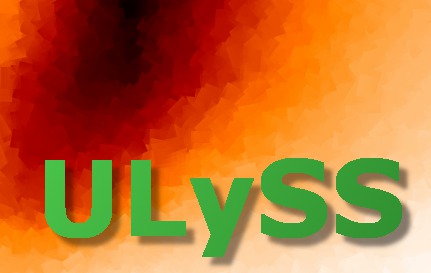
|

|
;+ ; NAME: ; ULY_FIT_INIT ; PURPOSE: ; Call the initialization function for each component of the fit ; ; USAGE: ; status = uly_fit_init(cmp, WAVERANGE=lamrange, ; VELSCALE=velscale, QUIET=quiet) ; ARGUMENTS: ; cmp : The array describing the model to fit, see ULY_FIT. ; ; KEYWORDS: ; WAVERANGE : (Input 2 elements double precision array) ; Wavelength range, in Angstrom. ; VELSCALE : (input) Size of the pixel in km/s. ; QUIET : Set this keyword to suppress some informational messages. ; ; RETURN VALUE: ; status is an error status, 0 for a sucessful completion. ; ; DESCRIPTION: ; The model to fit is described in the cmp array that can be created ; by, e.g., ULY_SSP. Each element of this array is a structure describing ; one component of the fit. One of the member of this structure is ; the name of the initialization function, and ULY_FIT executes these ; functions for each of the components. ; ; The initialization consists in operations that can be made once at ; the beginning to save computations at the time of the 'evaluation'. ; For example, the initialization may read a file, resample a model ; grid as the observation ... ; ; ULY_FIT_INIT must be called after reading the observation (because ; it needs to know the sampling and wavelength range) but before ; executing the fitting procedure ULY_FIT. ; ; HISTORY: ; Philippe Prugniel, 2008/05 created ;- ; CATEGORY: ULY ;------------------------------------------------------------------------------ function uly_fit_init, cmp, WAVERANGE=lamrange, VELSCALE=velscale, $ QUIET=quiet, NOREDO=noredo compile_opt idl2 on_error, 2 ; The 'NOREDO' keyword is used to prevent recursive re-entry wr = double(lamrange) for i=0, n_elements(cmp)-1 do begin if strtrim(cmp[i].init_fun,2) eq '' then begin cmp[i].start = alog(wr[0]) cmp[i].step = velscale / 299792.458d cmp[i].npix = 1 + round(alog(double(wr[1])/double(wr[0])) / cmp[i].step) cmp[i].sampling = 1 *cmp[i].eval_data = cmp[i] endif else $ cmp[i] = call_function(cmp[i].init_fun, cmp[i], WAVERANGE=wr, $ VELSCALE=velscale, QUIET=quiet) if cmp[i].start gt alog(wr[0]) then wr[0] = exp(cmp[i].start) if cmp[i].start+cmp[i].step*(cmp[i].npix-1) lt alog(wr[1]) then $ wr[1] = exp(cmp[i].start+cmp[i].step*(cmp[i].npix-1)) if cmp[i].sampling ne 1 then begin message, 'Some components of the model are not log-wave sampled ... ' + $ strjoin(cmp[i].name,','), /CONT return, 1 endif endfor start_min = min(cmp.start, MAX=start_max) cmp_end = cmp.start + (cmp.npix-1)*cmp.step end_min = min(cmp_end, MAX=end_max) ; If all the components do not have the same wavelength range, redo ; the initialization with the common range. This happens if the first ; CMP is not the one with the narrowest range. ; This is not very elegant, because we have to redo possibly heavy ; initialization computations, but it is the only way we have now. ; Hopefully this situation is not frequent, and it can be avoided by ; selecting an appropriate range in the observation we want to analyse. if start_max-start_min gt 0.02*velscale/299792.458d or $ end_max-end_min gt 1.02*velscale/299792.458d then begin wr = exp([start_max, end_min]) message, 'All the model components do not cover the same wavelength range...', /INFO if not keyword_set(noredo) then begin message, 'Initialization is redone with range ('+strjoin(strtrim(wr,2),',')+') ...', /INFO return , uly_fit_init(cmp, WAVERANGE=wr, VELSCALE=velscale, QUIET=quiet, /NOREDO) endif endif return, 0 end ;--- end ----------------------------------------------------------------------